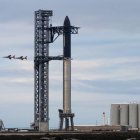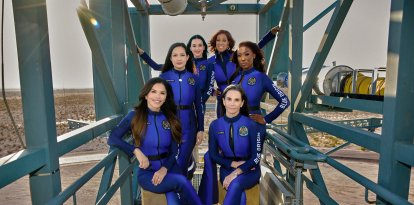SpaceX successfully launches 'Polaris Dawn,' the first civilian crew mission in history
The four travelers will be in orbit for the next five to six days and will visit Earth's radiation belts in what will be the first commercial trip to space.

SpaceX's 'Polaris Dawn' mission launches in Florida on Sept. 10, 2024
SpaceX successfully launched "Polaris Dawn" early Tuesday, the first civilian crew mission in history.
The spacecraft lifted off at 5:24 a.m. ET from Launch Complex 39A at NASA's Kennedy Space Center in Florida with four passengers aboard, as seen on X, the social network owned by Elon Musk that live-streamed the event:
The goal? To be in orbit for the next five to six days and allow these lucky travelers to visit Earth's radiation belts in what will be the first commercial journey into space in history as well as the highest orbital altitude reached by humans since the Apollo moon landing in 1972, taking them 870 miles above the Earth's surface.
A distance that, reports NBC News, reaches three times higher than the International Space Station.
The crew consists of Jared Isaacman, the billionaire entrepreneur who founded and serves as CEO of the payments company Shift4; Air Force lieutenant colonel Scott "Kidd" Poteet; and space engineers, Sarah Gillis and Anna Menon.

Technology
SpaceX to send four civilians on private space exploration for the first time
Sabrina Martin
All of them work for the Elon Musk-owned space company with the exception of Isaacman, who got a ticket on the mission by being one of those who funded the "Polaris Dawn," and all of them were addressed with words of encouragement from SpaceX launch director Frank Messina just after the capsule entered Earth's orbit:
"As you gaze towards the North Star, remember that your courage lights the path for future explorers. We trust your skills, your bravery, and your teamwork to carry out the mission that lies ahead. Know that the entire team back here is with you every step, watching, supporting and cheering you on as you walk into space. We’re sending you hugs from the ground," Messina said in statements reported by CNN.
The trip will not only allow the crew members to learn about Earth's radiation belts, it will also allow them to test the spacesuits and technologies being worked on by both SpaceX and NASA that will be used on upcoming long-duration missions to the Moon and, later, Mars.
Launching "Polaris Dawn" has not been easy. Scheduled for late August, the mission had to be postponed after engineers detected a helium leak on the launch pad.
It was then postponed again due to bad weather off the Florida coast predicted for the days when the SpaceX capsule is scheduled to land at the end of the mission, again delaying the expected launch, which has finally occurred.
RECOMMENDATION





















